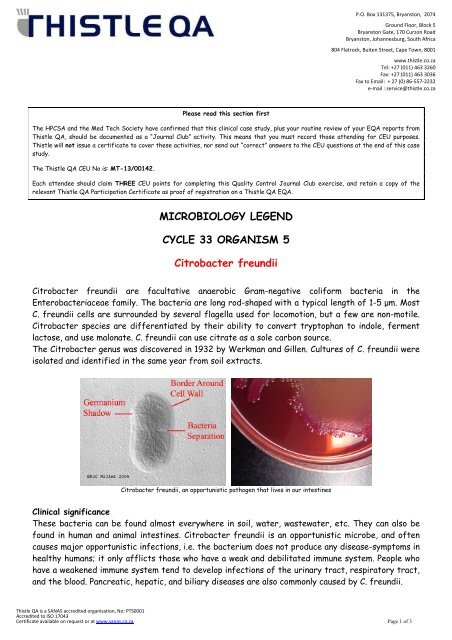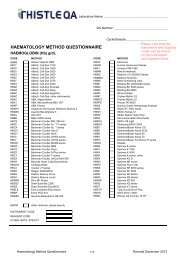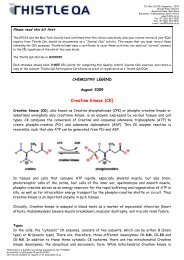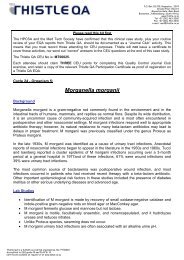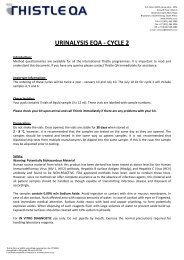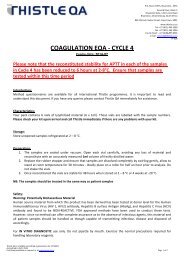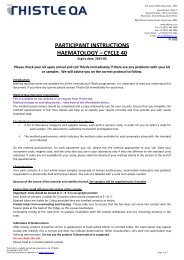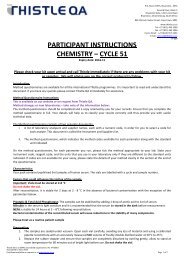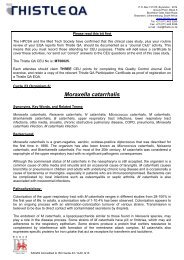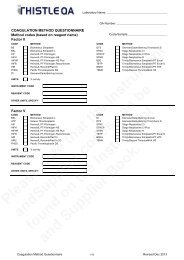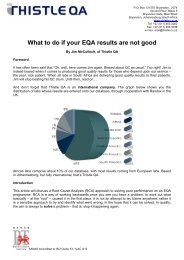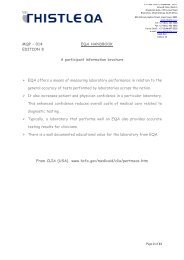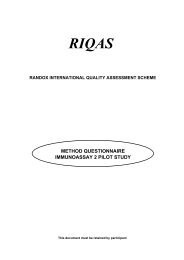Cycle 33 Organism 5 - Citrobacter freundii - Thistle QA
Cycle 33 Organism 5 - Citrobacter freundii - Thistle QA
Cycle 33 Organism 5 - Citrobacter freundii - Thistle QA
You also want an ePaper? Increase the reach of your titles
YUMPU automatically turns print PDFs into web optimized ePapers that Google loves.
Please read this section first<br />
P.O. Box 131375, Bryanston, 2074<br />
Ground Floor, Block 5<br />
Bryanston Gate, 170 Curzon Road<br />
Bryanston, Johannesburg, South Africa<br />
804 Flatrock, Buiten Street, Cape Town, 8001<br />
www.thistle.co.za<br />
Tel: +27 (011) 463 3260<br />
Fax: +27 (011) 463 3036<br />
Fax to Email: + 27 (0) 86‐557‐2232<br />
e‐mail : service@thistle.co.za<br />
The HPCSA and the Med Tech Society have confirmed that this clinical case study, plus your routine review of your E<strong>QA</strong> reports from<br />
<strong>Thistle</strong> <strong>QA</strong>, should be documented as a “Journal Club” activity. This means that you must record those attending for CEU purposes.<br />
<strong>Thistle</strong> will not issue a certificate to cover these activities, nor send out “correct” answers to the CEU questions at the end of this case<br />
study.<br />
The <strong>Thistle</strong> <strong>QA</strong> CEU No is: MT-13/00142.<br />
Each attendee should claim THREE CEU points for completing this Quality Control Journal Club exercise, and retain a copy of the<br />
relevant <strong>Thistle</strong> <strong>QA</strong> Participation Certificate as proof of registration on a <strong>Thistle</strong> <strong>QA</strong> E<strong>QA</strong>.<br />
MICROBIOLOGY LEGEND<br />
CYCLE <strong>33</strong> ORGANISM 5<br />
<strong>Citrobacter</strong> <strong>freundii</strong><br />
<strong>Citrobacter</strong> <strong>freundii</strong> are facultative anaerobic Gram-negative coliform bacteria in the<br />
Enterobacteriaceae family. The bacteria are long rod-shaped with a typical length of 1-5 μm. Most<br />
C. <strong>freundii</strong> cells are surrounded by several flagella used for locomotion, but a few are non-motile.<br />
<strong>Citrobacter</strong> species are differentiated by their ability to convert tryptophan to indole, ferment<br />
lactose, and use malonate. C. <strong>freundii</strong> can use citrate as a sole carbon source.<br />
The <strong>Citrobacter</strong> genus was discovered in 1932 by Werkman and Gillen. Cultures of C. <strong>freundii</strong> were<br />
isolated and identified in the same year from soil extracts.<br />
<strong>Citrobacter</strong> <strong>freundii</strong>, an opportunistic pathogen that lives in our intestines<br />
Clinical significance<br />
These bacteria can be found almost everywhere in soil, water, wastewater, etc. They can also be<br />
found in human and animal intestines. <strong>Citrobacter</strong> <strong>freundii</strong> is an opportunistic microbe, and often<br />
causes major opportunistic infections, i.e. the bacterium does not produce any disease-symptoms in<br />
healthy humans; it only afflicts those who have a weak and debilitated immune system. People who<br />
have a weakened immune system tend to develop infections of the urinary tract, respiratory tract,<br />
and the blood. Pancreatic, hepatic, and biliary diseases are also commonly caused by C. <strong>freundii</strong>.<br />
<strong>Thistle</strong> <strong>QA</strong> is a SANAS accredited organisation, No: PTS0001<br />
Accredited to ISO 17043<br />
Certificate available on request or at www.sanas.co.za Page 1 of 3
Symptoms<br />
1. Urinary tract infections caused by <strong>Citrobacter</strong> <strong>freundii</strong> trigger:<br />
a burning sensation during<br />
urination, increased urge to urinate,<br />
offensive smelling urine,<br />
scanty urination,<br />
blood in the urine<br />
fever<br />
burning or pain in the lower back and / or pelvis.<br />
P.O. Box 131375, Bryanston, 2074<br />
Ground Floor, Block 5<br />
Bryanston Gate, 170 Curzon Road<br />
Bryanston, Johannesburg, South Africa<br />
804 Flatrock, Buiten Street, Cape Town, 8001<br />
www.thistle.co.za<br />
Tel: +27 (011) 463 3260<br />
Fax: +27 (011) 463 3036<br />
Fax to Email: + 27 (0) 86‐557‐2232<br />
e‐mail : service@thistle.co.za<br />
2. C. <strong>freundii</strong> is also known to cause abnormal inflammatory changes in the intestine, sometimes<br />
even resulting in necrotic changes.<br />
3. <strong>Citrobacter</strong> <strong>freundii</strong> has been linked to neonatal meningitis as well. The meninges or coverings<br />
of the brain get inflamed due to bacterial infiltration. C. <strong>freundii</strong> has the capacity to break<br />
through the blood-brain barrier (comprising of the brain capillary endothelium and the choroid<br />
plexus epithelium). It can invade and replicate in the brain too. Common clinical features and<br />
<strong>Citrobacter</strong> <strong>freundii</strong> symptoms include:<br />
high grade fever<br />
projectile vomiting<br />
seizures.<br />
peritonitis and tunnel infection due to <strong>Citrobacter</strong> <strong>freundii</strong> have also been reported. This<br />
has most frequently been seen in hospitalized and immune-compromised patients who have<br />
been kept on ventilators and urinary catheter.<br />
Surprisingly, this infectious microbe in humans plays a positive role in the environment. C. <strong>freundii</strong><br />
is responsible for reducing nitrate to nitrite in the environment. This conversion is an important<br />
and crucial stage in the nitrogen cycle. The bacteria also help in recycling nitrogen. <strong>Citrobacter</strong><br />
<strong>freundii</strong> has also been investigated for biodegradation of tannic acid used in tanneries.<br />
C. <strong>freundii</strong> strains have inducible ampC genes encoding resistance to ampicillin and first-generation<br />
cephalosporin’s. In addition, isolates of <strong>Citrobacter</strong> may be resistant to many other antibiotics as a<br />
result of plasmid-encoded resistance genes<br />
Diagnoses<br />
Clinical features, demonstration of the infection, bacterial culture and imaging techniques such as<br />
X-rays and sonographies help make an accurate diagnosis. Quick and precise diagnosis is an<br />
important aspect of treating the C. <strong>freundii</strong> infection appropriately.<br />
Treatment<br />
<strong>Citrobacter</strong> <strong>freundii</strong> infection is usually treated with antibiotics like fluoroquinolones, carbapenems<br />
and cephalosporins. The treatment plan depends up on the vulnerability of the microbe to the<br />
antibiotics and the site of the infection. Conversely, there is a growing alarm over the levels of<br />
<strong>Thistle</strong> <strong>QA</strong> is a SANAS accredited organisation, No: PTS0001<br />
Accredited to ISO 17043<br />
Certificate available on request or at www.sanas.co.za Page 2 of 3
P.O. Box 131375, Bryanston, 2074<br />
Ground Floor, Block 5<br />
Bryanston Gate, 170 Curzon Road<br />
Bryanston, Johannesburg, South Africa<br />
804 Flatrock, Buiten Street, Cape Town, 8001<br />
www.thistle.co.za<br />
Tel: +27 (011) 463 3260<br />
Fax: +27 (011) 463 3036<br />
Fax to Email: + 27 (0) 86‐557‐2232<br />
e‐mail : service@thistle.co.za<br />
resistance of C. <strong>freundii</strong> to a number of antibiotics. Supportive treatment is given as well to hasten<br />
cure.<br />
Prognosis<br />
The overall prognosis for <strong>Citrobacter</strong> <strong>freundii</strong> infection is moderate. Untreated and neglected<br />
cases show extremely poor prognosis and almost always result in death. <strong>Citrobacter</strong> bacteremia<br />
commonly develops in elderly patients (65 %) and in hospitalized patients (77 %). The outcome for<br />
C. <strong>freundii</strong> urinary tract infection is good; whilst that for peritonitis is rather moderate to poor.<br />
The mortality rate of <strong>Citrobacter</strong> <strong>freundii</strong> meningitis is incongruously high, with the death rate of<br />
the patient ranging from 25 % to 50 %. Furthermore, serious neurological problems are known to<br />
persist in 75 % of the survivors.<br />
References<br />
1. http://www.citrobacter<strong>freundii</strong>.com/<strong>Citrobacter</strong>-Freundii-Symptoms.html<br />
Questions<br />
1. Discuss the morphological characteristics of <strong>Citrobacter</strong> <strong>freundii</strong>.<br />
2. Discuss the role of C. <strong>freundii</strong> in disease.<br />
3. Discuss the lab diagnosis of C. <strong>freundii</strong>.<br />
<strong>Thistle</strong> <strong>QA</strong> is a SANAS accredited organisation, No: PTS0001<br />
Accredited to ISO 17043<br />
Certificate available on request or at www.sanas.co.za Page 3 of 3


